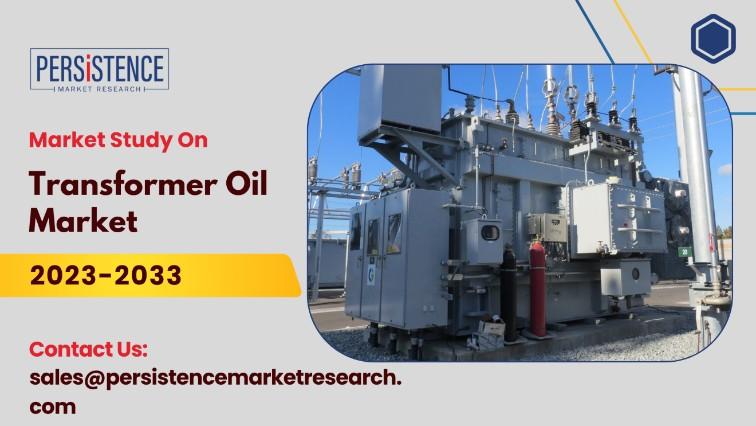Transformer Oil Market Dynamics: Crude Oil Fluctuations and
Regulatory Impacts
The global transformer oil market is set to grow significantly, reaching an estimated valuation of USD 10.1 billion by 2033, driven by a robust CAGR of 8.5% from 2024 to 2033. This growth is propelled by increased investments in power infrastructure, the expansion of electric grids, and the rising demand for electricity worldwide. Asia Pacific dominates the market with a 55% share. The surge in longdistance transmission lines and the adoption of ultra-high voltage power transformers are key factors fueling this growth, as these systems require substantial amounts of transformer oil for cooling and insulation.

Crude Oil Fluctuations: A Key Factor in Transformer Oil Pricing
The transformer oil market is closely linked to the fluctuations in crude oil prices due to the significant role that mineral-based oils play in the industry. Crude oil is the primary raw material for producing mineral-based transformer oils, and its price volatility can have substantial impacts on the transformer oil market.
Impact of Crude Oil Price Fluctuations:
Cost Variability: Changes in crude oil prices directly affect the cost of producing mineralbased transformer oils. When crude oil prices rise, the production costs for transformer oils increase, which can lead to higher prices for end-users. Conversely, a drop in crude oil prices can reduce production costs and, potentially, the prices of transformer oils.
Market Stability: Price volatility in crude oil markets can lead to instability in transformer oil pricing. This volatility can impact procurement strategies and financial planning for companies involved in the transformer oil supply chain.
Investment Decisions: Fluctuations in crude oil prices can influence investment decisions in the transformer oil industry. Companies may adjust their production capacities or explore alternative raw materials and formulations to mitigate the risks associated with crude oil price changes.
Regulatory Impacts: Shaping the Future of Transformer Oils
Regulatory factors play a crucial role in shaping the transformer oil market. Various regulations and standards impact the production, use, and disposal of transformer oils, influencing market dynamics and trends.
Key Regulatory Impacts:
Environmental Regulations: Environmental regulations are becoming increasingly stringent, driving the demand for eco-friendly and sustainable transformer oils. Regulations related to the reduction of greenhouse gas emissions and environmental impact are encouraging the adoption of bio-based and less harmful transformer oils.
o Bio-Based Oils: Regulations favoring sustainable practices are boosting the market for bio-based transformer oils, which are derived from renewable sources and have a lower environmental impact compared to traditional mineral-based oils.
o Recycling and Disposal: Regulations on the disposal and recycling of used transformer oils are also impacting the market. Companies must comply with regulations that mandate proper disposal and recycling practices to minimize environmental contamination.
Safety Standards: Safety regulations governing the performance and handling of transformer oils are influencing market trends. Standards related to fire resistance, thermal stability, and insulation properties ensure that transformer oils meet safety and performance requirements.
o Performance Standards: Transformer oils must meet specific performance standards to ensure reliable and safe operation of electrical systems. Compliance with these standards affects product development and market acceptance.
Regional Variations: Regulatory requirements can vary significantly by region, impacting market dynamics in different areas. Companies operating in multiple regions need to navigate diverse regulatory landscapes and adapt their products to meet local standards.
o North America: In North America, there is a strong focus on sustainability and environmental regulations, leading to increased demand for eco-friendly transformer oils.
o Europe: Europe has stringent environmental regulations that promote the use of bio-based and recycled transformer oils.
o Asia-Pacific: Regulatory environments in Asia-Pacific countries are evolving, with growing emphasis on environmental impact and safety standards.
Market Adaptations and Strategic Responses
To navigate the challenges posed by crude oil fluctuations and regulatory impacts, companies in the transformer oil market are adopting various strategies:
Diversification: Companies are diversifying their product portfolios to include alternative transformer oils, such as bio-based and synthetic options. This diversification helps mitigate the risks associated with crude oil price volatility and aligns with regulatory trends.
Innovation: Investing in research and development to create advanced transformer oil formulations that meet both performance and regulatory requirements is essential. Innovations in oil technology can provide a competitive edge and address emerging market needs.
Regulatory Compliance: Ensuring compliance with local and international regulations is critical for market participation. Companies must stay informed about regulatory changes and adapt their practices to meet evolving standards.
Cost Management: Implementing cost management strategies to address the impact of crude oil price fluctuations can help maintain market stability. Companies may explore costeffective production methods and supply chain efficiencies to manage cost pressures.
Conclusion
The transformer oil market is significantly influenced by crude oil price fluctuations and regulatory impacts. Crude oil price volatility affects production costs and market stability, while regulatory factors drive the adoption of sustainable and high-performance transformer oils. Companies that strategically adapt to these dynamics by diversifying their product offerings, investing in innovation, and ensuring regulatory compliance will be better positioned to navigate the challenges and capitalize on opportunities in the evolving transformer oil market.
